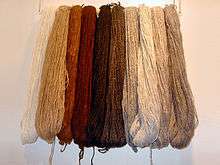African textiles
African textiles were often made of animal hair and woven. Some of the oldest surviving African textiles were discovered at the archaeological site of Kissi in northern Burkina Faso. They are made of wool or fine animal hair in a weft-faced plain weave pattern.[1] Some fragments have also survived from the thirteenth century Benin City in Nigeria.[2]
Some examples of African textiles are the following:
- Akwete cloth - woven by Igbo people
- Ukara - dyed indigo cloth by Igbo people
- Aso oke fabric - woven by Yoruba people
- Adire - tie-dye produced by Yoruba people
- Kente cloth - woven by Ashanti and Ewe people
- Barkcloth - produced by the Buganda tribe
- Mudcloth- produced by the Bambara tribe
- Kanga - produced in Tanzania
- Kitenge - produced in Tanzania and other regions of East Africa
- Chitenge - produced in Zambia
- Shweshwe – produced in South Africa
- Ankara or African Wax Prints - Produced in West Africa
Cultural significance
Weaving is of great importance in many African cultures. The Dogon, for example, believe that spinning and weaving thread can be likened to human reproduction and the notion of rebirth. The color of cloth is often of significance and is representative of specific qualities and attributes. For example, among the Ewe and Ashanti, black and white kente cloth is typically worn at funerals of elderly people to signify both a celebration of life and the mourning of death. In most cases end up with a widow wearing her late husbands apearal for several days.
African textiles can be used as historical documents.[3] cloth can be used to commemorate a certain person, event, and even a political cause. Much of the history conveyed had more to do with how others impacted the African people, rather than about the African people themselves The tapestries tell stories of Roman and Arab invasions, and how the impact of Islam and Christianity affected African life. The same is true of major events such as colonialism, the African Slave Trade, even the Cold War.[4]
African textiles also have significance as historical documents, offering perspectives in cases where written historical accounts are unavailable: "History in Africa may be read, told and recorded in cloth."[5]
References
- Magnavita, S. 2008. The oldest textiles from sub-Saharan West Africa: woolen facts from Kissi, Burkina Faso. Archived 2014-11-04 at the Wayback Machine Journal of African Archaeology 8 (2), 243-257.
- Christopher Spring, African Textiles, (New York: Crescent) 1989, p. 3
- Gott, Suzanne. Loughran, Kristyne. (2010). Contemporary African fashion. Indiana University Press. ISBN 978-0-253-00140-5. OCLC 747431637.CS1 maint: multiple names: authors list (link)
- Spring, Christopher (2012). African textiles today. London: The British Museum Press ; [Washington, DC] : Smithsonian Books, in association with British Museum Press. ISBN 9781588343802.
- Spring, Chris (2012). African Textiles Today. Washington DC: Smithsonian Books. pp. 32–33. ISBN 9781588343802.
